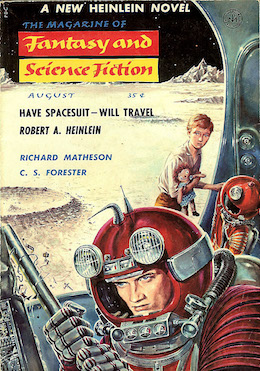In this bi-weekly series reviewing classic science fiction and fantasy books, Alan Brown looks at the front lines and frontiers of the field; books about soldiers and spacers, scientists and engineers, explorers and adventurers. Stories full of what Shakespeare used to refer to as “alarums and excursions”: battles, chases, clashes, and the stuff of excitement.
There are many gateways into science fiction—books that are our first encounter with a world of limitless possibilities. And because we generally experience them when we are young and impressionable, these books have a lasting impact that can continue for a lifetime. In the late 20th Century, among the most common gateways to SF were the “juvenile” books of Robert A. Heinlein. The one that had the biggest impression on me opened with a boy collecting coupons from wrappers on bars of soap, which starts him on a journey that extends beyond our galaxy. Wearing his space suit like a knight of old would wear armor, young Clifford “Kip” Russell sets out on a quest that will ultimately become entangled with the fate of all mankind.
I can’t remember exactly what edition of Have Space Suit—Will Travel I read first; I suspect it was a library edition. Sometime thereafter, I bought a paperback copy of my own. I certainly didn’t pick it for its cover, which portrayed the hero in his space suit with the Earth behind him, and the faces of many of the other characters in shades of green around the globe, floating like severed heads in space. Jarringly, the artist left out the main female protagonist, perhaps thinking that boys would not want a book with a girl’s face on the cover (but regardless of the reason, at least we were spared the sight of her portrayed as a severed, greenish head). This cover suffers by comparison to the best cover that has ever graced the story: the painting on the cover of the serialized version in Fantasy and Science Fiction. There were two other Heinlein juveniles I read at about the same time: Tunnel in the Sky and Citizen of the Galaxy. I don’t remember a lot of details from most of the books I read at that age, but I clearly remember those three. The characters, the settings, and the action all stuck in my mind.
About the Author and His Juvenile Series
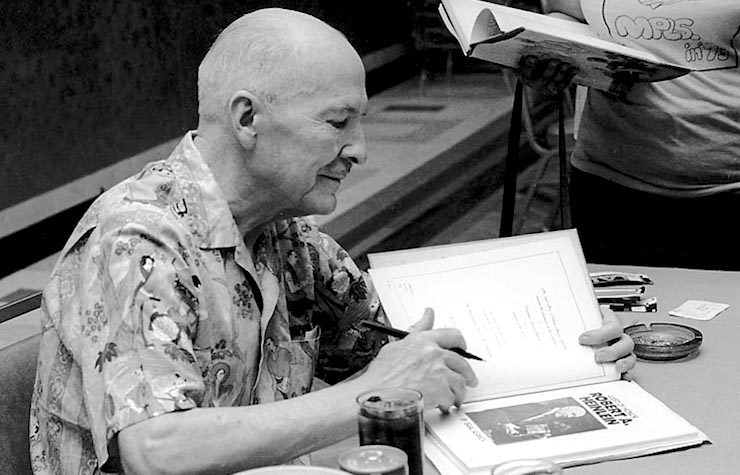
Robert Anson Heinlein (1907-1988) is among the most influential science fiction writers of the 20th Century. He was widely known both within and outside the science fiction community. His stories appeared not only in magazines like Astounding, Fantasy and Science Fiction and Galaxy, but in mainstream publications like the Saturday Evening Post. He co-wrote the script for George Pal’s movie Destination Moon.
In 1947, Heinlein sold the novel Rocket Ship Galileo to Charles Scribner’s Sons, a firm interested in publishing a series of juvenile science fiction novels targeted at young boys. This started a series of a dozen novels that appeared from 1947 to 1958, and after Rocket Ship Galileo came Space Cadet, Red Planet, Farmer in the Sky, Between Planets, The Rolling Stones, Starman Jones, The Star Beast, Tunnel in the Sky, Time for the Stars, Citizen of the Galaxy, and Have Space Suit—Will Travel. The books were all very popular, but Heinlein often argued with the publisher regarding suitable subject matter for youngsters. His stories often put the young protagonists in very grown-up situations including wars, revolutions, and catastrophes. His thirteenth book for the series, Starship Troopers, with its portrayal of a harsh, militaristic society locked in total war, proved too much for Scribner’s (I reviewed the book here). Heinlein then sold it to another publisher, and never looked back. No longer fettered by the puritanical limits of the juvenile market, he went on to write some of his best work: Stranger in a Strange Land, The Moon is a Harsh Mistress, and Glory Road. The novel Podkayne of Mars is sometimes considered a Heinlein juvenile, but it technically was a separate work that grew from a non-SF female character that Heinlein liked and put into an SF setting. It was published by G. P. Putnam’s Sons in 1963, after the Scribner’s run of novels had finished.
The juveniles are not set in Heinlein’s more rigid Future History, although there are certainly similarities throughout. In recent years, my son and I set out to read all the juveniles that we had missed, and I found that more often than not, the settings of the books were pretty grim. While Heinlein shows mankind spreading out into the Solar System and then to the stars beyond, he repeatedly espouses the Malthusian notion that human population would grow out of control until war or catastrophe intervened. He frequently portrays governments that grow ever more totalitarian, and suggests that only on the frontiers could individual freedom be found. There are also some interesting clues to his future works in these early books—the powers of the mysterious Martians of Red Planet, for example, bear a striking resemblance to those later portrayed in Stranger in a Strange Land.
The social settings of the juveniles also can be jarring. The clichéd families, with the father serving as breadwinner and ruler of the household and the mother portrayed as obedient, passive, and nurturing, can set modern teeth on edge. While the male protagonists are all clearly beyond puberty, they display an indifference to females more appropriate to a boy in the pre-puberty latent phase of development. I wonder if this was something imposed on Heinlein by the publisher, as his own opinions in these areas were far more liberal.
The juveniles, however, excel in making the future seem believable, and are populated by characters the reader can identify with. And to a young reader, the grim challenges the protagonists faced in the books were the stuff of excitement. The books offered a view of how young people could face even the most daunting of challenges and overcome them. They offered a model of self-reliance and empowerment for the reader. It is no wonder they are remembered long after “safer” youth-oriented entertainment has been forgotten.
Have Space Suit—Will Travel
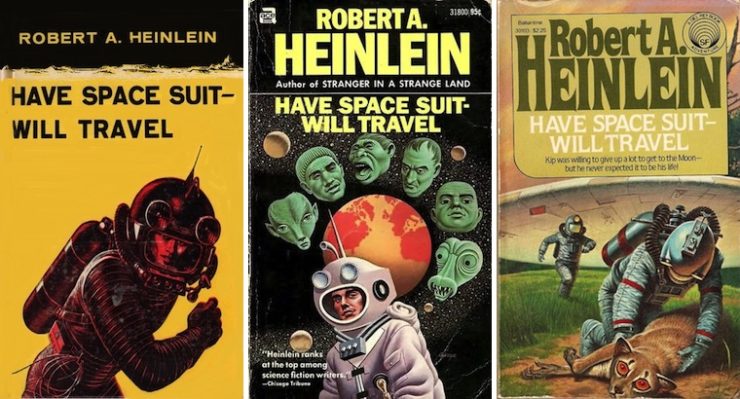
When we first meet Kip, he has just decided to go to the Moon. While mankind has established stations in orbit and on the moon, this is easier said than done. Kip, the son of an eccentric genius, is a senior in Centerville High School who works as a soda jerk at the local pharmacy (the assumption that there would still be soda jerks in drug stores in the future is one of Heinlein’s rare failures of vision). Kip has limited prospects of attending a first-rate college and knows that few people, even those at the top of their fields, get the opportunity to visit the Moon. So he decides on a novel method of achieving his goal: a soap slogan contest that offers the winner a free trip to the Moon. He begins to collect wrappers for the contest and draws mockery from local bully Ace Quiggle.
In the end, Kip does not win the contest, but he does win another prize: a surplus but functional space suit. Kip, a lifelong tinkerer, is fascinated by the suit, and soon decides to restore it to working condition. The description of the suit could have easily become a lump of exposition in the hands of another author. But Heinlein shows us that experience through Kip’s eyes, and through the restoration of the suit’s functions we not only learn how the suit works, but we see the process as an adventure in and of itself.
After he has fully restored the suit, learned how to use it, and even named it (“Oscar”), Kip decides that keeping it doesn’t make sense, and decides to sell it to raise money for college. First, however, he goes out into the night to take it for one last spin around the nearby fields. He uses his radio to make a call using imaginary call signs, and is surprised when “Peewee” answers. In a coincidence of the type that can only be used sparingly in fiction, there is a young girl, Patricia Wynant Reisfeld, nicknamed Peewee, on the other end of the radio call, desperate for help. Two UFOs land in front of Kip, there is a battle, and when he awakens, he finds that he is a prisoner aboard one of the ships.
Peewee is daughter of a noted scientist and has been kidnapped by malevolent aliens (nicknamed the “Wormfaces” by Kip) aided by two renegade humans, who want to use her as leverage to influence her scientist father. An alien that Peewee calls the “Mother Thing” attempted to rescue her, but is now a prisoner herself. Kip soon finds that the ship has landed on the Moon and he has achieved his goal, albeit in a manner he never could have predicted. He and Peewee escape the room they are trapped in, discover their captors gone, and find the Mother Thing and their space suits. Kip makes room in his suit for the Mother Thing, and they begin a walk to the nearest human outpost, which in my mind ranks among one of the most gripping episodes in science fiction. The fact that this was written in the days when space suits and moon walks were only gleams of possibility in the eyes of engineers and scientists makes Heinlein’s achievement even more impressive. They deal with challenges like incompatible bayonet and screw-jointed gas bottles with adhesive tape and ingenuity. In the end, however, their efforts are in vain. They are recaptured, and then are taken to Pluto, the Wormfaces’ main base in the Solar System. On Pluto, Kip and Oscar will face challenges that make their moon walk seem like a walk in the park.
At this point, each subsequent stage of the book represents a jump to situations even more strange and wonderful than the last. Heinlein takes advantage of the story not being in a fixed future history to turn the place of mankind in the universe completely on its head. While science fiction often shows us strange and wonderful worlds, this is the first science fiction book I remember that left me disoriented and even dizzy from what I had read.
On Chivalry and Chauvinism
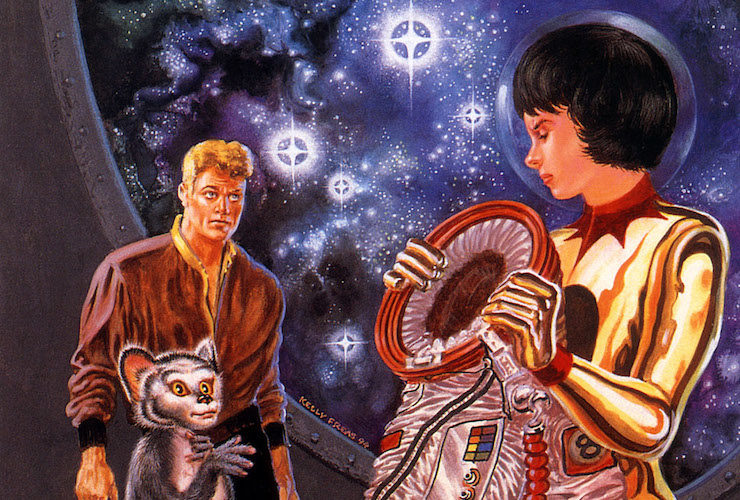
While I highly recommend introducing young readers to Have Space Suit—Will Travel, it should probably be presented along with a discussion of gender roles. As I mentioned above, the Heinlein juveniles often present pictures of gender roles that were becoming archaic even when the books were written. Kip’s passive mother, for example, is almost part of the background, rather than a character of her own. And while Peewee is portrayed as having agency to spare, there are often statements suggesting that such behavior is unseemly for a young girl. Kip, on the other hand, is depicted as an exemplar of what at the time were considered masculine virtues. While its setting is science fiction, Have Space Suit—Will Travel is also a meditation on the issue of chivalry, with Kip’s space suit symbolizing a suit of armor that he uses in a noble quest. When he meets Peewee, he immediately decides that he needs to take care of her, or die trying. And during the tale, he comes very near losing his life several times. In his head, Kip frequently muses on tales of knights and heroes, and it is obvious that he has internalized these tales. But in addition to internalizing the virtues of chivalry, he has also learned some troubling chauvinistic attitudes, and a few pages after committing himself to die for her, he is threatening Peewee with spanking. All of which raises a problem that many older tales present to modern readers: How do we separate the sexism that sees certain virtues and roles as distinctly male and female from the fact that those virtues still have value to our society? How do we apply principles like “women and children first” in a world where women fight in combat side by side with men?
We can and should still present stories such as Have Space Suit—Will Travel to young people. But then we need to talk about them, and discuss what concepts are still important, and what our society is trying to learn from and leave behind. Our authors of today have a challenge, as well. How can they portray the virtues of heroism and sacrifice without the baggage of sexism? One model I can think of is Ann Leckie’s Ancillary trilogy, which takes many tropes that are near and dear to me, such as chivalry, nobility, duty and honor, and strips them away from their connection to gender (and even from a connection to a specific biological form). The result is like a breath of fresh air, and the protagonist, Breq, stands among some of the most admirable characters I have ever encountered. We need to give the Kips and Peewees of the future new models for the positive traits we need, without the baggage of past attitudes.
Final Thoughts
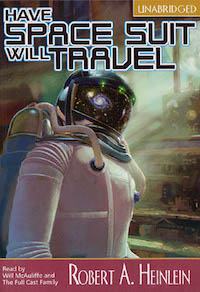 Before I end the discussion, I must mention the way in which I most recently experienced the story of Have Spacesuit—Will Travel, which is by listening to a full cast reading from Full Cast Audio. A full cast reading is partway between an audio drama which tells the story through dialogue and sound effects, and a straight reading of the book. Each speaking part is given a different actor, which helps draw you into the story, but the presence of a narrator keeps the experience closer to that of reading the original book. Bruce Coville and the team at Full Cast Audio have produced all the Heinlein juveniles in this format, and I highly recommend it as a way to experience the stories.
Before I end the discussion, I must mention the way in which I most recently experienced the story of Have Spacesuit—Will Travel, which is by listening to a full cast reading from Full Cast Audio. A full cast reading is partway between an audio drama which tells the story through dialogue and sound effects, and a straight reading of the book. Each speaking part is given a different actor, which helps draw you into the story, but the presence of a narrator keeps the experience closer to that of reading the original book. Bruce Coville and the team at Full Cast Audio have produced all the Heinlein juveniles in this format, and I highly recommend it as a way to experience the stories.
Have Spacesuit—Will Travel will always remain one of my favorite books. It starts out rooted in a world that seems so ordinary, and in the relatively mundane issue of space suit engineering, but moves on to more and more exotic locales, and finally to exploring concepts of what it means to be human and the nature of civilization. It is a ride that has rarely been duplicated in all of literature.
And now, as always, it is your turn to give your thoughts. What did you think about Have Spacesuit—Will Travel, or Heinlein’s other juveniles? And what are your thoughts on the place of chivalry in a changing world?
Alan Brown has been a science fiction fan for over five decades, especially fiction that deals with science, military matters, exploration and adventure.










